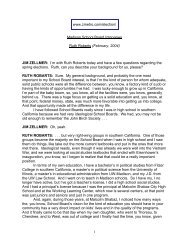census
census
census
You also want an ePaper? Increase the reach of your titles
YUMPU automatically turns print PDFs into web optimized ePapers that Google loves.
HEALTH INSURANCE<br />
COVERAGE IN THE<br />
UNITED STATES<br />
Highlights<br />
• The number of people with health<br />
insurance coverage increased from<br />
245.9 million in 2004 to 247.3 million<br />
in 2005. 31<br />
• In 2005, 46.6 million people were<br />
without health insurance coverage,<br />
up from 45.3 million people in<br />
2004 (Table 8).<br />
• The percentage of people without<br />
health insurance coverage<br />
increased from 15.6 percent in<br />
2004 to 15.9 percent in 2005.<br />
• The historical record is marked by a<br />
12-year period from 1987 to 1998<br />
when the uninsured rate (12.9 percent<br />
in 1987) either increased or<br />
was not statistically different from<br />
one year to the next (Figure 7). 32<br />
After peaking at 16.3 percent in<br />
1998, the rate fell for 2 years in a<br />
row to 14.2 percent in 2000. The<br />
rate then increased until<br />
2003–2004, where it remained at<br />
31<br />
The 2004 data have been revised to reflect a<br />
correction to the weights in the 2005 ASEC, and the<br />
estimates were revised based on improvements to<br />
the algorithm that assigns coverage to dependents.<br />
For a brief description of how the Census Bureau<br />
collects and reports on health insurance, see the<br />
text box “What Is Health Insurance Coverage?” For a<br />
discussion of the quality of ASEC health insurance<br />
coverage estimates, see Appendix C.<br />
32<br />
The year 1987 is the first year for which<br />
comparable health insurance coverage statistics<br />
are available.<br />
What Is Health Insurance Coverage?<br />
The Annual Social and Economic Supplement (ASEC) to the Current<br />
Population Survey (CPS) asks about health insurance coverage in the previous<br />
calendar year. The questionnaire asks separate questions about the<br />
major types of health insurance, and people who answer “no” to each of<br />
the coverage questions are then asked to verify that they were, in fact,<br />
not covered by any type of health insurance. For reporting purposes, the<br />
Census Bureau broadly classifies health insurance coverage as private coverage<br />
or government coverage. Private health insurance is a plan provided<br />
through an employer or a union or purchased by an individual from a private<br />
company. Government health insurance includes the federal programs<br />
Medicare, Medicaid, and military health care; the State Children’s<br />
Health Insurance Program (SCHIP); and individual state health plans.*<br />
People were considered “insured” if they were covered by any type of<br />
health insurance for part or all of the previous calendar year. They were<br />
considered “uninsured” if they were not covered by any type of health<br />
insurance at any time in that year.<br />
Research shows health insurance coverage is underreported in the CPS<br />
ASEC for a variety of reasons. While annual retrospective questions appear<br />
to be less of a problem when collecting income data (possibly because the<br />
interview period is close to when people pay their taxes), it is probably<br />
less than ideal when asking about health insurance coverage. For example,<br />
some people may report their insurance coverage status at the time<br />
of their interview rather than their coverage status during the previous<br />
calendar year. Compared with other national surveys, the CPS ASEC’s estimate<br />
of the number of people without health insurance more closely<br />
approximates the number of people who were uninsured at a specific<br />
point in time during the year than the number of people uninsured for the<br />
entire year.<br />
For more information on the quality of CPS ASEC health insurance estimates,<br />
see Appendix C, “Estimates of Health Insurance Coverage.” For a<br />
comparison between health insurance coverage rates from the major federal<br />
surveys, see How Many People Lack Health Insurance and for How<br />
Long? (Congressional Budget Office, May 2003) and People with Health<br />
Insurance: A Comparison of Estimates from Two Surveys (Survey of<br />
Income and Program Participation Working Paper 243, June 2004).<br />
* Types of insurance are not mutually exclusive and people may be covered by more than<br />
one during the year.<br />
20 Income, Poverty, and Health Insurance Coverage in the United States: 2005 U.S. Census Bureau





